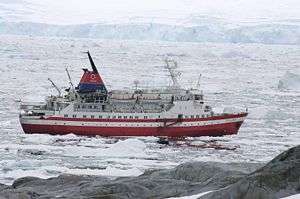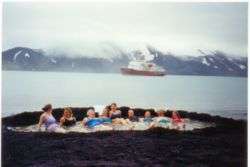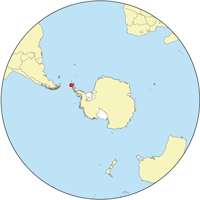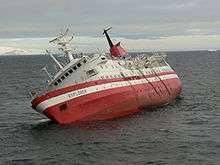MV Explorer (1969)
 MS Explorer in 2005 | |
| History | |
|---|---|
| Name: |
|
| Owner: |
|
| Port of registry: |
|
| Builder: | Uudenkaupungin Telakka, Uusikaupunki, Finland |
| Laid down: | 1969 |
| Launched: | 14 December 1969 |
| Out of service: | 23 November 2007 |
| Identification: |
|
| Fate: | Sank after hitting an iceberg on 23 November 2007 at 62°24′S 57°16′W / 62.400°S 57.267°W. |
| Status: | Sunk. Final wreck position at (62°24′18″S 57°11′46″W / 62.404882°S 57.196247°W) |
| General characteristics | |
| Tonnage: | 2398 |
| Length: | 239 ft (73 m) |
| Beam: | 46 ft (14 m) |
| Draught: | 14 ft 7 in (4.45 m) |
| Ice class: | ICE-1A (as per BNV, equals Finnish-Swedish IA)[2] |
| Propulsion: | 2 × MaK diesel M452 AK each 1,800 bhp (1,300 kW), driving a single variable-pitch propeller, 4 blades |
| Speed: | 12.5 knots (23 km/h) |
| Capacity: | 104 passengers |
| Crew: | 54 |
MS Explorer was a Liberian-registered cruise ship designed for Arctic and Antarctic service, originally commissioned and operated by the Swedish explorer Lars-Eric Lindblad. Observers point to Explorer's 1969 expeditionary cruise to Antarctica as the forerunner for today's sea-based tourism in that region.[3][4]
The vessel was originally named MS Lindblad Explorer (until 1985), and MS Society Explorer until 1992. Ownership of the vessel changed several times, the last owner being the Toronto-based travel company G.A.P Adventures which acquired Explorer in 2004.[1]
Explorer was the first cruise ship used specifically to sail the icy waters of the Antarctic Ocean, and the first to sink there[5] when she struck an unidentified submerged object (USO) on 23 November 2007, reported to be ice, which caused a 10 by 4 inches (25 by 10 cm) gash in the hull.[6] Explorer was abandoned in the early hours of 23 November 2007 after taking on water near the South Shetland Islands in the Southern Ocean, an area which is usually stormy but was calm at the time.[7] Explorer was confirmed by the Chilean Navy to have sunk at approximate position 62° 24′ South, 57° 16′ West, between South Shetlands and Grahams Land, in the Bransfield Strait,[8] where the depth is roughly 600 m.[9] The Royal Navy Antarctic Patrol Ship Endurance, at the request of the Foreign and Commonwealth Office whilst carrying out a hydrographic survey for the British Antarctic Survey, later pinpointed Explorer's final resting place as 62° 24′ 17.57″ South, 57° 11′ 46.49″ West at an approximate depth of 1,130 m, a distance of 4,373 m from its reported sinking position. This is broadly consistent with the direction of the prevailing current.[10]
History

Explorer was commissioned by Lars-Eric Lindblad, the Swedish-American pioneer of exotic expedition tours, and built in 1969 at Uudenkaupungin Telakka shipyard[11] in Uusikaupunki, Finland. The ship was built to stay afloat with two compartments filled with water. Her original Finnish-Swedish ice class was 1C, which is relatively weak. It is not known when the ice class was uprated to 1A.[12]
The vessel was originally named Lindblad Explorer after Lars-Eric Lindblad and was the first custom built expeditionary cruise ship. On 11 February 1972 Explorer ran aground near La Plaza Point, Antarctica; her passengers, Lars-Eric Lindblad among them, were rescued by the Chilean Navy.[13] She was towed to Buenos Aires, Argentina and then to Kristiansand, Norway, for repairs.[14]
On 25 December 1979 Lindblad Explorer ran aground off Wiencke Island in the Antarctic. The 70 passengers and 34 of the crew were rescued by the Chilean Navy icebreaker Piloto Pardo, leaving the captain and a skeleton crew of 21 on board to await the arrival of a tug.[15]
In 1984, Explorer was the first cruise ship to navigate the Northwest Passage. In 1989 she was involved in the rescue of the crew of an Argentine supply ship that had hit a rock ledge off Anvers Island, Antarctica.[16]
In 1998, Explorer was the first ship to circumnavigate James Ross Island;[17] and the same year, she is claimed to have been the first ship, as distinct from river boat, to sail 80 miles (130 km) above Iquitos, Peru, to the point where the Marañón and Ucayali rivers meet to become the Amazon River.[18]
Explorer was depicted on at least two postage stamps issued by South Georgia and one issued by the Falkland Islands.[19][20]Explorer was nicknamed the Little Red Ship.[21]
Sinking




Explorer departed from Ushuaia, Argentina on 11 November 2007 on a 19-day cruise intended to trace the route of 20th century explorer Ernest Shackleton through the Drake Passage (an area typically stormy with rough seas). After visiting the Falkland Islands and South Georgia she hit an iceberg in the Bransfield Strait close to King George Island in the Southern Ocean, near the South Shetland Islands, on 23 November 2007. The object struck by Explorer made a reported 10-by-4-inch (25 by 10 cm) gash in the hull which allowed water to enter. The Argentine navy later said in a statement it observed "significant" damage.[6]
Passengers on Explorer reported a loud "bang" at the time of impact, although others reported that there had been no noticeable impact, or at least nothing more than the normal crunching of ice experienced when sailing through icy waters. One passenger reported sea water in their cabin at about 03:00 UTC.[22][23] Some reports also indicate that the ship drifted into an iceberg on Explorer's starboard side while the crew was assessing damage caused by the original impact, also to the starboard side of the ship.[24]
A mayday call was put out by the ship at 04:24 UTC, and rescue operations were quickly coordinated by the Prefectura Naval (Coast Guard Corps) of Argentina and the Chilean Navy Center for Search and Rescue. Chile dispatched the icebreaker Almirante Viel, and nearby commercial ships including the MN Ushuaia, the National Geographic Endeavor, and the Norwegian Coastal Express ship MS Nordnorge which was operating as a passenger cruise ship at the time.[25] By 07:30 UTC, all 91 passengers, 9 guides and 54 crew,[26] from over 14 countries,[27][28] were evacuated and had taken to the Explorer's lifeboats. The evacuees drifted for 5 hours until they were picked up by the Norwegian ship MS Nordnorge which arrived on scene at approximately 10:00 UTC.[17][29]
All of those rescued by Nordnorge were taken to the Chilean Frei Montalva Station on King George Island where they were subsequently airlifted by C-130 Hercules transport aircraft of the Chilean Air Force to Punta Arenas, Chile[17] in two separate flights, one on Saturday 24 November and the other on Sunday 25 November. Those passengers not taken to Punta Arenas (an estimated 70) were taken to Uruguay's Artigas Base. Explorer was completely submerged at 19:00 UTC, approximately 20 hours after the initial impact and damage to her hull.[30]
Explorer was designed, like most ships, with compartments which could be sealed off by watertight doors; the ship would not sink if holed and one compartment flooded, but was not safe if more compartments were flooded, either by a gash spanning compartments or imperfect sealing between compartments. GAP reported that there was a crack in addition to the hole, but it is not clear if it spanned compartments.[31]
In an article published on 8 December 2007, experts consider that Explorer was "perfect for ice navigation", and consider that the explanation of the sinking "doesn't add up" and that "essential pieces of the story are missing".[32]
Company statements
On the morning of Friday 23 November 2007, G.A.P. Adventures issued the following statement:
GAP Adventures, owners of the expedition ship, M/S Explorer, have confirmed that all 100 passengers and crew who were on board M/S Explorer when it hit ice in the Bransfield Strait off King George Island, Antarctica, earlier today are safe and uninjured.Standard procedures were followed by the crew with passengers calmly evacuated to the ship's life rafts and then transferred to the Nordnorge, which was in the area.
The M/S Explorer's crew are also now on the Nordnorge.
On board M/S Explorer were two Argentines, 10 Australians, two Belgians, 24 British nationals, 12 Canadians, one Chinese national, three Danes, 17 Dutch, one French, one German, two from Hong Kong, four Irish, one Japanese, four Swiss, 14 Americans, one Colombian and one Swede.
The families of those passengers are now being telephoned by GAP Adventures to advise them of the safety of their loved ones.
At 10:00 EST, Saturday 24 November 2007, G.A.P. Adventures issued the following updated statement:
All passengers and crew, including the captain of M/S Explorer, are completely safe, uninjured and in good spirits. The passengers spent the night at King George Island in Antarctica. There are plans for passengers to board flights today and tomorrow to Punta Arenas, Chile. Accommodations have been arranged in Punta Arenas and flights home from there are currently being scheduled.The passengers include 2 Argentines, 10 Australians, 2 Belgians, 24 British nationals, 12 Canadians, 1 Chinese national, 3 Danes, 17 Dutch, 1 French, 1 German, 2 from Hong Kong, 4 Irish, 1 Japanese, 4 Swiss, 14 Americans, 1 Colombian and 1 Swede. The captain of the ship is Swedish and the majority of the crew are understood to be from the Philippines. The crew on board M/S Explorer consist of 45 Filipinos, 4 Swedes, 2 Bulgarians, 2 New Zealanders, and 1 Pole.
We can now confirm that at 19:00 GMT, Friday, 23 November, M/S Explorer sank.
Investigation
The investigation into the sinking of Explorer was carried out by the Liberian Bureau of Maritime Affairs. The report into the accident was released in April 2009.[2]
The report cites the decision by the Master of the vessel to enter the ice field based on his knowledge and information available at the time as the primary reason why Explorer suffered the casualty. "He was under the mistaken impression that he was encountering first year ice when in fact, as the Chilean Navy Report indicated, was much harder land ice."
Passengers reported seeing red paint on the passing ice less than thirty minutes prior to when the flooding was reported, another indication that the vessel was passing through compact and hard ice. The Master of Explorer was very experienced in Baltic waters but he was unfamiliar with the type of ice he encountered in Antarctic waters.[2]
The report praises the performance of the master and crew in organizing and evacuating the passengers, and notes that lives were likely saved due to the actions of these individuals.[2]
References
- 1 2 Possibly also named MS World Explorer after 1985
- 1 2 3 4 5 "Report of Investigation in the Matter of Sinking of Passenger Vessel EXPLORER (O.N. 8495) 23 November 2007 in the Bransfield Strait near the South Shetland Islands" (PDF). Bureau of Maritime Affairs, Liberia. Retrieved 8 April 2009.
- ↑ Mar 28 – Hump Day, British Antarctic Survey.
- ↑ Scope of Antarctic Tourism — A Background Presentation, IAATO official website.
- ↑ Reel, Monte (24 November 2007). "Cruise Ship Sinks Off Antarctica". The Washington Post. Retrieved 13 May 2010.
- 1 2 "154 Rescued From Sinking Ship in Antarctic: Passengers, Crew Boarding Another Ship After Wait In Lifeboats; No Injuries Reported". CBS News. 23 November 2007. Retrieved 23 November 2007.
- ↑ "Doomed Ship Defies Antarctica Odds". Reuters. 25 November 2007. Archived from the original on 27 November 2007. Retrieved 28 November 2007.
- ↑ "MS Explorer – situation report". The Falkland Islands News. 23 November 2007.
- ↑ MV EXPLORER Cruise Ship Sinking In South Atlantic, The Shipping Times, 23 November 2007
- ↑ "Royal Navy Locates Antarctic Wreck of Cruise Liner". Fleet Media & Communication, Royal Navy. Retrieved 15 March 2008.
- ↑ Finnish: Uudenkaupungin telakka
- ↑ "Explorer syntyi talvisodan hengessä" (in Finnish). Aamulehti. 23 November 2007. Archived from the original on 24 November 2007.
- ↑ Lars-Eric Lindblad, 67, Pioneer Of Tours to Exotic Destinations, The New York Times, 13 July 1994.
- ↑ Erik Langeland
- ↑ Caffin, J.M. (ed.). "Lindblad Explorer runs aground" (PDF). Antarctic. 9 (1): 35–36. Retrieved 3 February 2016.
On her way back to Ushaia, Tierra del Fuego, where she was due on December 30, the Lindblad Explorer passed by Wiencke Island, which lies between Anvers Island and the west coast of the Antarctic Peninsula. She was off Cape Astrup at the north-eastern end of the island when she ran aground. A sunken rock with less than 1.8m of water over it lies about 402m north of the cape.
- ↑ Pavia, Will; Strange, Hannah; Bone, James (24 November 2007). "Iceberg blamed as passengers flee holed ship in icy waters". London: The Times. Retrieved 28 November 2007.
- 1 2 3 "Cruise boat sinking off Argentina". BBC News. 23 November 2007. Retrieved 23 November 2007.
- ↑ M/S Explorer
- ↑ Philatelie Polaire South Georgia stamps.
- ↑ Falkland Isles Stamp
- ↑ "Stricken Antarctic ship evacuated". BBC News. 24 November 2007. Retrieved 28 November 2007.
- ↑ Antarctic cruise ship tourists live to tell 'Titanic 2' jokes, The Daily News (New York), 25 November 2007.
- ↑ Ulster grandad set for home after Antarctic rescue drama, The Belfast Telegraph, 26 November 2007.
- ↑ Canadian ship lost in Antarctic, The Toronto Star, 24 November 2007.
- ↑ "Armada apoya labores de rescate de buque de pasajeros Explorer" (in Spanish). Chilean Navy. 23 November 2007. Archived from the original on 25 November 2007. Retrieved 23 November 2007.
- ↑ The crew of 54 was made up largely of Filipinos, 45 of whom were aboard.
- ↑ G.A.P. Adventures listed: 24 Britons, 17 Dutch, 14 Americans, 12 Canadians and 10 Australians, 4 Swedes, 4 Irish, 3 Danes, 2 Argentines, 2 Belgians, 2 Chinese (Hong Kong), and single passengers from China, France, Germany, Japan, Colombia, Sweden. Not clarified, are earlier reports of 2 New Zealanders, 2 Bulgarians, and 1 Pole.
- ↑ Reel, Monte (25 November 2007). "Passengers of Doomed Cruise Ship Reach Chile With Vivid Accounts". The Washington Post. pp. A18.
- ↑ "Passengers are being rescued from M/S Explorer". Dagbladet. 23 November 2007. Retrieved 23 November 2007.
- ↑ "Passengers unhurt after Antarctic ship hits ice". Reuters UK. 24 November 2007. Retrieved 23 November 2010.
- ↑ International Herald Tribune
- ↑ Christian Science Monitor
External links
| Wikimedia Commons has media related to Explorer (ship, 1969). |
| Wikinews has related news: |
- MS Explorer – G.A.P Adventures
- Explorer – Det Norske Veritas Exchange Vessel Information.
- M/S Explorer – Eagle Eye Tours
- BT.no webcam of bad list, title reads Here Explorer sinks – earlier stillphotos from Nordnorge
- MS Explorer anchored off Elephant Island, Antarctica picture at Flickr.com
- M.S Explorer Slideshow At Yahoo News – Yahoo News Slideshow
- Eye witness account of the rescue – Audrey's Blog
- Picture of the ship sinking published on "Clarin" newspaper website – "Clarin" online edition 25 November 2007, Argentina. (Spanish)
- Erik Langeland
- Lindbeck
- Passenger account – Dennis's Blog
- Another passenger's detailed text and photo account – by Andy White
- Passenger account from cabin 314, where the breach occurred – by Eli Charne
- Published first hand analysis report of the evacuation and rescue (RINA Journal "The Naval Architect", February 2008, pp 16–18) – by Naval Architect Andy White (PDF)
- Photos taken on the last voyage of the M/S Explorer – by Eli Charne
- Final investigation report, PDF
Coordinates: 62°14′S 57°10′W / 62.24°S 57.16°W